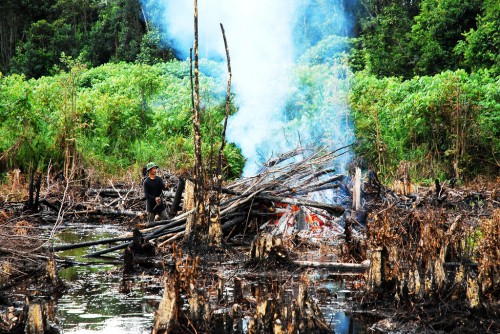BOGOR, Indonesia (06 July, 2012)_ In the Amazon, it’s called
Terra Preta. In the tribal tongues of Indonesia’s East Kalimantan province, it’s called
tiem by the lowland Merap and
punyuh
by the upland Punan. In all three languages, the meaning is the
same:“Black Soil,” an apt description of the dark, nutrient-rich soil
pockets prized by forest-dwelling tribes in the tropics.
A multidisciplinary research team led by a pair of CIFOR scientists
has found evidence that the “Black Soil” of Indonesia’s Kalimantan
province, like its Amazon analogue, is “anthropogenic” – a product of
decades, if not centuries, of human cultivation. They make their case in
a
new paper in the journal
Forestry.
If borne out by further study, the sites in Kalimantan would be the
first scientifically documented instance of Anthropogenic Dark Earths
(ADEs) in tropical Asia. The phenomenon has been noted in Latin America
from the early twentieth century.
However, nearly 20,000 kilometres apart, both the Amazonian and
Indonesian ADEs are thought to originate in the same style of farming:
“Slash-and-char” cultivation rather than the more common slash-and-burn
pattern.
“What we are seeing in [our research site at] Malinau [East
Kalimantan] is evidence that ADEs caused by ‘Slash and char’ techniques
leads to improved soil quality, and are not necessarily, as some
believe, the result of some long-lost knowledge in the Amazon,” says
Douglas Sheil, the lead author of the paper and a scientist with
CIFOR’s Forests and Environment Programme. “These improvements in the
soil can sequester large-amounts carbon, protect forest diversity and
help improve sustainable agriculture in regions that are already
deforested and giving poor yields.”
“These soils could be developed in low-tech and low cost ways that
can reduce pressure on land and improve sustainable food security where
land is scarce,” he added.
Sheil cautions that it is not fully understood how ADEs originated.
However, the 15-percent carbon levels exhibited in the soil are
understood to be largely thanks to “char.”

Shifting agriculture—which includes both “slash and burn” and “slash and char” methods–is practiced by many tribal peoples.
With the “slash and burn” method, trees and other woody plant are
cleared and burned when preparing land for planting — this generates
soil nutrients that temporarily improve productivity. When the burn-off
is thorough, leaving only ash, the soil enrichment is relatively
short-lived and the field must lie fallow for longer before it is ready
to re-use.
However, a partial burn-off, or “slash-and-char” method, enhances
soil structure and provides a longer-lasting store for nutrients that
are gained from various sources but likely reflect food processing and
wastes associated with sustained human presence. Overtime, if the
clearing-char-nutrient additions cycle is repeated, the result is a
build-up of ADEs.
The increase in soil fertility allows indigenous populations to
sustain themselves without the use of costly chemical fertilisers. It
also helps to conserve forest diversity and boosts
carbon sequestration five- to seven-fold, which can last for centuries, even millennia, compared to surrounding rainforest land.
From field interviews, researchers learned that farmers living in
Kalimantan’s upper Malinau river basin, clear fields by a method more
akin to “slash and burn.” “Slash and char” methods mainly occurred
unintentionally, when frequent rain blots out the burn prematurely.
This was probably why only two plots of the 202 plots surveyed had the 15-percent carbon levels seen in the Amazon
Terra Preta samples, said Sheil’s co-author and fellow CIFOR researcher, Imam Basuki.
Basuki adds that the new research presents a convincing argument for
why slash and char methods should be used by local communities to
improve the soil fertility. “This is solid evidence showing farmers and
local policy makers that this system will increase their own rice
productivity,” he added.
Although remote, the Malinau region is crucially important as a
watershed for East Kalimantan, including the provincial capital. It is also a biodiversity “hotspot”, as recognised by the World Wildlife Fund in its “
Heart of Borneo” conservation campaign.
All the more reason, Basuki said, to promote slash-and-char in
Kalimantan. If soil enrichment through “slash and char” can be achieved
inadvertently, how much more could be achieved through deliberate
efforts?
Source:
Cifor 



















